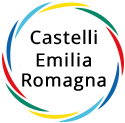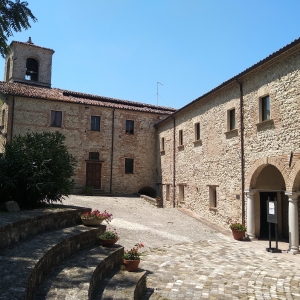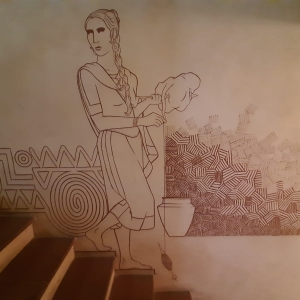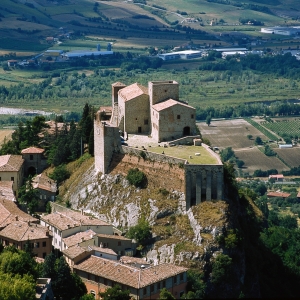EVENTO TRASCORSO
Women forging stories. Female creativity between painting and tradition
Museo Civico Archeologico Villanoviano
Events may be subject to change, always contact organizers before going to the venue.
EVENT LINK
ARCHAEOLOGICAL MUSEUM, CHURCH OF SANT'AGOSTINO
A cycle of three meetings dedicated to the rediscovery and study of the fundamental contribution of women in art between the Renaissance and Baroque periods. Art historians will guide the public in the discovery of female artists including Elisabetta Sirani, Lavinia Fontana and Sofonisba Anguissola, through the most recent studies emerging in Italy and abroad. A unique opportunity to get to know and appreciate the work of these artists who have left an indelible mark on the history of art.
PROGRAMME
A cycle of three meetings dedicated to the rediscovery and in-depth study of the fundamental contribution of women in art between the Renaissance and the Baroque. Art historians will guide the audience in the discovery of female artists, including Elisabetta Sirani, Lavinia Fontana and Sofonisba Anguissola, through the most recent studies emerging in Italy and abroad. A unique opportunity to get to know and appreciate the work of these artists who have left an indelible mark on the history of art.
Sunday 9 March at 10.30 am | The Diary of Elisabetta Sirani | Massimo Pulini
Presentation of the new monograph 'The Diary of Elisabetta Sirani', edited by Massimo Pulini. In his latest work, the author presents more than fifty previously unpublished works by Elisabetta Sirani, including paintings, drawings and engravings, which add to the many already known works by a painter who only had ten years to express her talent. A new face emerges from this research, enriched by Elisabetta's unique graphic style, expressed in an innovative practice that combines ink painting with line drawing. Also presented are several dispersed paintings that made the artist famous and earned her praise and sonnets during her lifetime. The series of Apostles and Evangelists is re-emerging, for which she was given the definition of a virile brush, and through which Sirani responds, with her own grace, to the Bolognese, Carraccan tradition of philosophical Heads of Character.
Massimo Pulini has written numerous essays on 16th and 17th century Italian art and curated various museum exhibitions. He is responsible for the catalogue raisonné of the works of Andrea Lilio (Federico Motta 2003), Ginevra Cantofoli (Editrice Compositori 2006), the three Cesena painters Razzani, Serra and Savolini (Tre artisti nella cesena del Seicento, Medusa 2021), Giovan Francesco Nagli (Centino. Lo sguardo laterale, NFC editions, 2023) and the last of the Caravaggio painters Bartolomeo Mendozzi (NFC editions, 2022). From 2011 to 2019, he was the promoter of the Biennale del Disegno di Rimini, curating the three editions as director of the scientific committee. In recent years, he has held the course of Art and the Market at the Sapienza University of Rome and currently holds the chair of Painting at the Academy of Fine Arts in Bologna.
Sunday 16 March at 10.30 a.m. | Bolognese Artists of the Renaissance | Irene Graziani
The lecture will focus on the "phenomenon" of the woman artist in Bologna, starting with the figure of Caterina Vigri, a Poor Clare nun at Corpus Domini, author of an illuminated breviary still preserved in the Bolognese monastery, and moving on to the sculptress Properzia de' Rossi, the only artist mentioned in Giorgio Vasari's Lives, active in the building site of San Petronio in 1525-1526, and finally the painter Lavinia Fontana, who in the Bologna of the Carracci tackled all artistic genres, ending her career in the service of prestigious patrons in the Rome of the popes.
Irene Graziani is an associate professor at the University of Bologna. She works on eighteenth-century Bolognese painting. Her research topics concern the activity of Bolognese artists working in the cosmopolitan courts of Europe; portraiture; artistic production linked to paths of mystical contemplation; the Bolognese phenomenon of the woman artist. His contributions include: La bottega dei Torelli. From Bologna to the Russia of Catherine the Great, 2005; Properzia de' Rossi. Una scultrice a Bologna nell'età di Carlo V, 2008 (with Vera Fortunati); Sognare l'Arcadia. Stefano Torelli, 'peintre enchanteur' in the great courts of Northern Europe, 2013; Luigi Crespi portraitist in the age of Pope Lambertini, exhibition held in 2017; William Keable, Joseph Nollekens and James Barry. Tre artisti inglesi nella Bologna del Settecento, 2019; Jacopo Alessandro Calvi, accademico e pittore, 2022.
Sunday 22 March at 10.30 | Self-portrait of a woman between the 16th and 17th centuries | Cecilia Gamberini
This conference aims to create a path through the history of the self-portrait through artists such as Catherina Van Hemessen, Lavinia Fontana, Sofonisba Anguissola, Artemisia Gentileschi, Elisabetta Sirani and Clara Peeters, analysing this particular pictorial genre in the 16th and 17th centuries. From the mid-16th century onwards, the figure of the woman painter appeared on the Italian art scene. In addition to the education received at home, young women had to acquire a cultural background that included expertise in the art of painting. This particular type of practice aroused great astonishment in the society of the time, which clamoured for their presence through the genre of self-portraiture. Indeed, in order to be accepted in cultured circles, it was necessary to create a self-image that respected the topos of the virtuous woman, a model that included those characteristics appreciated by the general public. These women painters investigated in a very personal and unique way the way of self-representation, succeeding in gaining widespread social recognition in a world dominated by the cumbersome presence of men.
Cecilia Gamberini graduated in art history from the University of Bologna under the guidance of Daniele Benati and continued her education at the Autonomous University of Madrid, with a doctoral thesis defended cum laude and with international mention, entitled 'Sofonisba Anguissola, de Cremona a la corte de Felipe'. She teaches literature and history and her studies have focused particularly on gender history in the 16th century, court studies and women artists. She has recently published a monograph on Sofonisba Anguissola, published by the Lundhumpries publishing house in London.
From 9.30 a.m. at the Church of Sant'Agostino it will also be possible to buy and taste artisanal products together with Tiee Pane e Caffè di Verucchio. A delicious breakfast in an evocative location to discover the history of a centuries-old tradition, from the processing of ancient grains to the valley project, and the story of women returning to work with mother yeast.
Free lectures with compulsory booking;
Breakfast/tasting on payment directly on site.
Tickets:
Free conference + breakfast tasting by Tiee Pane e Caffè on payment according to consumption
Booking required: https://shorturl.at/xBvsI
For information and reservations
0541 670280 | archeologicoverucchio@atlantide.net
A cycle of three meetings dedicated to the rediscovery and study of the fundamental contribution of women in art between the Renaissance and Baroque periods. Art historians will guide the public in the discovery of female artists including Elisabetta Sirani, Lavinia Fontana and Sofonisba Anguissola, through the most recent studies emerging in Italy and abroad. A unique opportunity to get to know and appreciate the work of these artists who have left an indelible mark on the history of art.
PROGRAMME
A cycle of three meetings dedicated to the rediscovery and in-depth study of the fundamental contribution of women in art between the Renaissance and the Baroque. Art historians will guide the audience in the discovery of female artists, including Elisabetta Sirani, Lavinia Fontana and Sofonisba Anguissola, through the most recent studies emerging in Italy and abroad. A unique opportunity to get to know and appreciate the work of these artists who have left an indelible mark on the history of art.
Sunday 9 March at 10.30 am | The Diary of Elisabetta Sirani | Massimo Pulini
Presentation of the new monograph 'The Diary of Elisabetta Sirani', edited by Massimo Pulini. In his latest work, the author presents more than fifty previously unpublished works by Elisabetta Sirani, including paintings, drawings and engravings, which add to the many already known works by a painter who only had ten years to express her talent. A new face emerges from this research, enriched by Elisabetta's unique graphic style, expressed in an innovative practice that combines ink painting with line drawing. Also presented are several dispersed paintings that made the artist famous and earned her praise and sonnets during her lifetime. The series of Apostles and Evangelists is re-emerging, for which she was given the definition of a virile brush, and through which Sirani responds, with her own grace, to the Bolognese, Carraccan tradition of philosophical Heads of Character.
Massimo Pulini has written numerous essays on 16th and 17th century Italian art and curated various museum exhibitions. He is responsible for the catalogue raisonné of the works of Andrea Lilio (Federico Motta 2003), Ginevra Cantofoli (Editrice Compositori 2006), the three Cesena painters Razzani, Serra and Savolini (Tre artisti nella cesena del Seicento, Medusa 2021), Giovan Francesco Nagli (Centino. Lo sguardo laterale, NFC editions, 2023) and the last of the Caravaggio painters Bartolomeo Mendozzi (NFC editions, 2022). From 2011 to 2019, he was the promoter of the Biennale del Disegno di Rimini, curating the three editions as director of the scientific committee. In recent years, he has held the course of Art and the Market at the Sapienza University of Rome and currently holds the chair of Painting at the Academy of Fine Arts in Bologna.
Sunday 16 March at 10.30 a.m. | Bolognese Artists of the Renaissance | Irene Graziani
The lecture will focus on the "phenomenon" of the woman artist in Bologna, starting with the figure of Caterina Vigri, a Poor Clare nun at Corpus Domini, author of an illuminated breviary still preserved in the Bolognese monastery, and moving on to the sculptress Properzia de' Rossi, the only artist mentioned in Giorgio Vasari's Lives, active in the building site of San Petronio in 1525-1526, and finally the painter Lavinia Fontana, who in the Bologna of the Carracci tackled all artistic genres, ending her career in the service of prestigious patrons in the Rome of the popes.
Irene Graziani is an associate professor at the University of Bologna. She works on eighteenth-century Bolognese painting. Her research topics concern the activity of Bolognese artists working in the cosmopolitan courts of Europe; portraiture; artistic production linked to paths of mystical contemplation; the Bolognese phenomenon of the woman artist. His contributions include: La bottega dei Torelli. From Bologna to the Russia of Catherine the Great, 2005; Properzia de' Rossi. Una scultrice a Bologna nell'età di Carlo V, 2008 (with Vera Fortunati); Sognare l'Arcadia. Stefano Torelli, 'peintre enchanteur' in the great courts of Northern Europe, 2013; Luigi Crespi portraitist in the age of Pope Lambertini, exhibition held in 2017; William Keable, Joseph Nollekens and James Barry. Tre artisti inglesi nella Bologna del Settecento, 2019; Jacopo Alessandro Calvi, accademico e pittore, 2022.
Sunday 22 March at 10.30 | Self-portrait of a woman between the 16th and 17th centuries | Cecilia Gamberini
This conference aims to create a path through the history of the self-portrait through artists such as Catherina Van Hemessen, Lavinia Fontana, Sofonisba Anguissola, Artemisia Gentileschi, Elisabetta Sirani and Clara Peeters, analysing this particular pictorial genre in the 16th and 17th centuries. From the mid-16th century onwards, the figure of the woman painter appeared on the Italian art scene. In addition to the education received at home, young women had to acquire a cultural background that included expertise in the art of painting. This particular type of practice aroused great astonishment in the society of the time, which clamoured for their presence through the genre of self-portraiture. Indeed, in order to be accepted in cultured circles, it was necessary to create a self-image that respected the topos of the virtuous woman, a model that included those characteristics appreciated by the general public. These women painters investigated in a very personal and unique way the way of self-representation, succeeding in gaining widespread social recognition in a world dominated by the cumbersome presence of men.
Cecilia Gamberini graduated in art history from the University of Bologna under the guidance of Daniele Benati and continued her education at the Autonomous University of Madrid, with a doctoral thesis defended cum laude and with international mention, entitled 'Sofonisba Anguissola, de Cremona a la corte de Felipe'. She teaches literature and history and her studies have focused particularly on gender history in the 16th century, court studies and women artists. She has recently published a monograph on Sofonisba Anguissola, published by the Lundhumpries publishing house in London.
From 9.30 a.m. at the Church of Sant'Agostino it will also be possible to buy and taste artisanal products together with Tiee Pane e Caffè di Verucchio. A delicious breakfast in an evocative location to discover the history of a centuries-old tradition, from the processing of ancient grains to the valley project, and the story of women returning to work with mother yeast.
Free lectures with compulsory booking;
Breakfast/tasting on payment directly on site.
Tickets:
Free conference + breakfast tasting by Tiee Pane e Caffè on payment according to consumption
Booking required: https://shorturl.at/xBvsI
For information and reservations
0541 670280 | archeologicoverucchio@atlantide.net
WHERE
Via Sant' Agostino, 14, Verucchio, (RN)
free
DAYS & TIMES
| March-2025 | ||||||
| Mon | Tue | Wed | Thu | Fri | Sat | Sun |
| 24 | 25 | 26 | 27 | 28 | 01 | 02 |
| 03 | 04 | 05 | 06 | 07 | 08 | 09 |
| 10 | 11 | 12 | 13 | 14 | 15 | 16 |
| 17 | 18 | 19 | 20 | 21 | 22 | 23 |
| 24 | 25 | 26 | 27 | 28 | 29 | 30 |
| 31 | 01 | 02 | 03 | 04 | 05 | 06 |
View schedules on highlighted days by clicking on them
INFO & TICKETS
Villanovian Municipal Archaeological Museum
0541 670280
Via Sant’Agostino 14, 47826, Verucchio, (RN)
26 December to 6 January, open daily from 10 a.m. to 6 p.m.
Museo Civico Archeologico Villanoviano also offers
You might also be interested in...
Verucchio (RN)
15 Dec 2024 -
14 Dec 2025
Between Sky and Stone: the Rocca del Sasso fortress and the rule of the Malatesta.
Verucchio (RN)
06 Apr -
02 Jun 2025
Sigismondo and Federico. Magnificent Lords, perfidious tyrants
Verucchio (RN)
18 May -
21 Dec 2025





